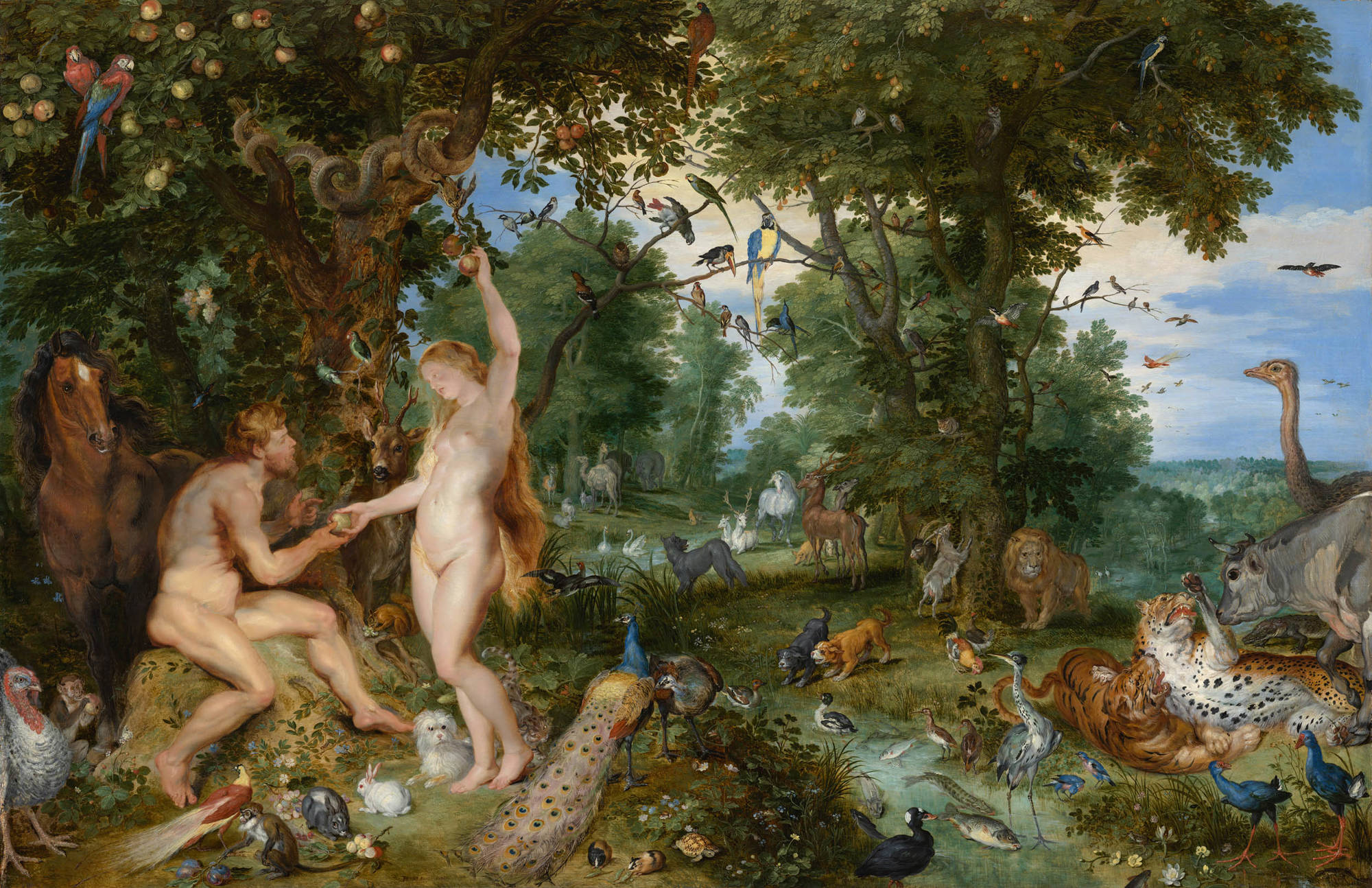This spectacular painting was produced jointly by two specialists, which was not an unusual phenomenon in the seventeenth century. In this case Rubens painted the two nudes while Brueghel executed the landscape and the animals. They both signed the work: ‘PETRI PAVLI RVBENS FIGR’ is inscribed on the left and ‘IBRUEGHEL FEC.’ on the right. This indicates that Peter Paul Rubens painted the figures and Jan Brueghel produced the work as a whole. The somewhat wider brushstrokes in which Adam and Eve are executed can be clearly distinguished from the finer strokes in the details of the plants and animals, such as the tortoise’s shell and the leopard’s coat. Rubens’s share in the work is far greater than the inscription suggests. He also painted the horse, the serpent, and the tree.
Jan Brueghel the Elder was the second son of the famous Pieter Bruegel the Elder, also known as ‘Peasant Bruegel’. Jan Brueghel’s earliest paintings date from 1592-1595 and were made in Rome, where he had settled. In 1595-1596 he was in Milan in the service of Cardinal Federico Borromeo, who would become a lifelong friend. In 1596 Jan Brueghel relocated to Antwerp, dedicating himself to animal and flower pieces, which he executed with great precision on the basis of studies from nature. His large oeuvre earned him the nicknames ‘Flower Brueghel’, ‘Velvet Brueghel’ and ‘Paradise-Brueghel’. From 1606 onwards he worked as a painter at the court of the regents Archduke Albert and the Infanta Isabella in Brussels, but continued to live in Antwerp. He produced almost twenty paintings in collaboration with his fellow townsman and friend Rubens.
The episode depicted here is the moment at which Eve, having accepted the apple from the serpent, gives it to Adam, who will presently eat the forbidden fruit. This constitutes the Fall of Man, after which Adam and Eve are expelled from paradise. Brueghel has gone to great lengths to bring the Garden of Eden to life for us. Amid a charming landscape he has depicted countless animals, from large camels to minuscule birds, many of them in pairs. The meticulous rendering of the animals reveals that Brueghel had been able to observe most of these animals at first hand. In a letter dating from 1621 to Federico Borromeo, the painter wrote that he was observing and painting birds and animals in the menagerie of Albert and Isabella. On a small panel with studies of donkeys, apes and cats, we find at lower left the little monkey that is sitting behind Adam and the cat that is nuzzling Eve.
The painters also incorporated symbolic allusions into the scene. Thus, the little monkey behind Adam is taking a bite of an apple. Since monkeys resemble human beings but lack the moral faculty needed to distinguish between good and evil, they were often used in the seventeenth century to symbolise evil and sinfulness. In this scene the monkey presages Adam’s imminent deed. A strikingly illuminated bunch of grapes, in the otherwise dark foliage, hangs over Adam’s head. These grapes – the wine made from which is equated with the blood of Christ during the celebration of the Eucharist – are undoubtedly an allusion to the Crucifixion, which takes away the sins of mankind, thus reversing the Fall. Subtle references of this kind may seem far-fetched, but they will certainly have been understood by seventeenth-century art lovers, who were used to looking at paintings in this way.
A painting such as this one served first and foremost as a ‘spectacle piece’. The aim was to overwhelm viewers with the two specialists’ astonishing painting technique. To acquire a painting made by two such outstanding masters was the fondest wish of any wealthy or princely collector. This certainly applied to Prince William V, who acquired the work in 1766 at the auction of the collection of Pieter de la Court in Leiden. He paid the incredible sum of 7,350 guilders for it, over ten times the price fetched by paintings by Anthony van Dyck or Jacob Jordaens.
(this is a reworked version of a text published in in: P. van der Ploeg, Q. Buvelot, Royal Picture Gallery Mauritshuis: A princely collection, The Hague 2005)













